|
|
| Hong Kong Philatelic |
![]()
|
INTERNATIONAL REPLY COUPONS SERVICES IN HONG KONG ~ By Wilson W S Yeung ~ |
|
The Hong Kong Post Office formally commenced operation on 24 August 1841 under Mr. T. G. Fitzgibbon only seven months after Hong Kong was first occupied by the British Forces on 26 January 1841. ¡@ On 12 November 1841, a small building was erected as Post Office, on a little hill just above the site of the present St. John¡¦s Cathedral. ¡@ The first Hong Kong postage stamps were issued on 8 December 1862. The issue consisted of 1,040,160 stamps of seven denominations, the highest of which was 96 cents. ¡@ Hong Kong Post Office joined the Universal Postal Union (UPU) on 1 April 1877. The idea of issuing International Reply Coupons ¡V better known as ¡§Universal Stamps¡¨ which is exchangeable in any membership postal administration of the Universal Postal Union for the minimum postage for an unregistered priority item or unregistered letter to a foreign country was first proposed by the British Colonies of Australasia to the 1906 Rome Congress, concerning the creation of an ¡§International Reply Stamp¡¨. ¡@ Among one of the membership postal administrations under the United Kingdom delegations, Hong Kong issued its first International Reply Coupons on 1 October 1907 at a face value of 12 cents. The name ¡§HONG KONG¡¨ was printed in italics with lines between four languages texts on reverse. This Coupon was printed by V. Benziger & Co. A. G. Einsedeln of Switzerland with UNION POSTALE / UNIVERSELLE Watermark. At around 1917, small modification was made with the difference being only twelve lines on the reverse side and the shorter German text reads ¡§getauscht¡¨. ¡@ A number of revisions of the layout were made since then the name ¡§HONG KONG¡¨ is now in bold face lettering. Selling price increased to 16 cents. Later on, selling price again increased to 24 cents at around 1922. ¡@ Another change of the layout was made at the 1929 London Congress and the colour was changed from blue to grey-blue design and text with very pale yellow background printing. Selling price in Hong Kong went down to 16 cents at around 1930 and soon revised to 40 cents at around 1939. Firstly, a rubber chop of ¡§40¡¨ was being used to overprint on the 16 cents Coupon until the shipment of 40 cents coupon arrived from the Switzerland. Price was adjusted to 45 cents just before Hong Kong¡¦s Occupation by the Japanese Army in 1941. Specially printed 45 cents Coupons was issued in 1945 right after the surrender of the Japanese and the end of the Second World War. ¡@ At around 1951, price was changed to 55 cents. Firstly, the new denomination was overprinted on the 45 cents Coupons by applying a rubber chop (Picture 1) until later on the newly printed 55 cents Coupons arrived at Hong Kong (Picture 2). The text on the back shows the removal of the Italian and German paragraphs and the addition of Russian, Arabic, and Chinese in their place. The variation within the type was caused by the difference in the size of the printer¡¦s imprint: 18mm versus 13mm. |
|
 |
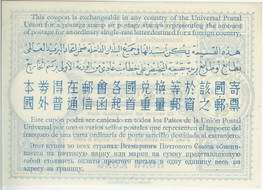 |
| Picture 1 | |
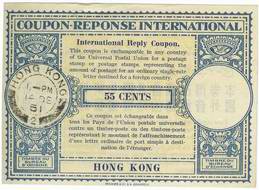 |
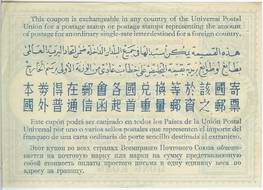 |
| Picture 2 | |
|
Price increased to 60 cents at around 1954 with a rubber chop being applied to overprint old denomination Coupons still on hand (Picture 3). At around 1955, the newly printed 60 cents Coupons was issued (Picture 4). This type may be quickly identified by the words ¡§FORMULE C22¡¨ at the upper right hand corner of the front. German language is printed again as one of the six languages on the back of the Coupon. The two variations are differentiated by the position of the full stop under the word ¡§amount¡¨. |
|
 |
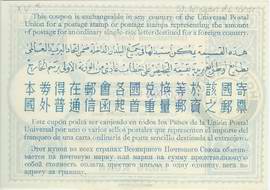 |
| Picture 3 | |
 |
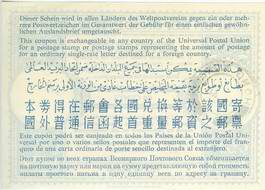 |
| Picture 4 | |
|
Price was revised to 75 cents at around 1959 with a rubber chop being used to overprint the old denomination Coupons (Picture 5) until the arrival of 75 cents Coupons shipment at around end 1960 (Picture 6). |
|
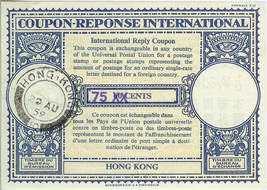 |
 |
| Picture 5 | |
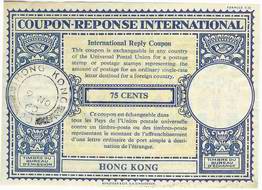 |
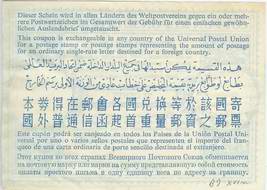 |
| Picture 6 | |
|
Released at around 1963, the new shipment of Coupons could be readily identified by the ¡§C22¡¨ at the upper right hand corner of the front. Printer was Benziger & Cie. S. A. Einsiedeln of Switzerland (Picture 7). |
|
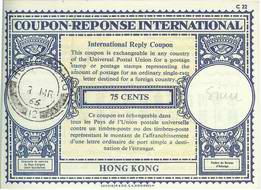 |
 |
| Picture 7 | |
|
A new type of International Reply Coupons was introduced and adopted by the 1964 Vienna Congress. New format with a brighter blue frame and pale yellow background and the name of Issuing Administration is imprinted in red. This Coupon is easily identifiable by a single large UPU Watermark and the Printer¡¦s name is being removed. This kind of Coupon was first put into use in Hong Kong at around December 1965 (Picture 8 and Picture 9). |
|
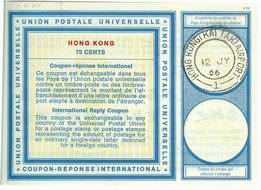 |
 |
| Picture 8 | |
 |
 |
| Picture 9 | |
|
Selling price was increased to 80 cents at the middle of 1969 with a rubber chop being applied to the old 75 cents Coupon still in circulation (Picture 10) until the arrival of the newly printed 80 cents at around end 1969 (Picture 11). |
|
 |
 |
| Picture 10 | |
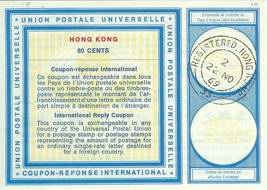 |
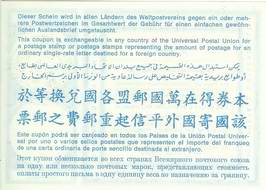 |
| Picture 11 | |
|
In 1971, a new denomination of HKD1.20 International Reply Coupons was being ordered and delivered before the new price was effective. A small modification was made with the French text on front now ends ¡§l¡¦etranger¡Ksurface.¡¨ However, with a shortage of the old 80 cents Coupons for daily counter usage, a small amount of the newly delivered HKD1.20 was being applied by a rubber chop of 80 cents in June 1971 for using approximately one month only (Picture 12). |
|
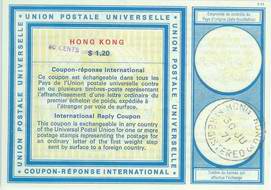 |
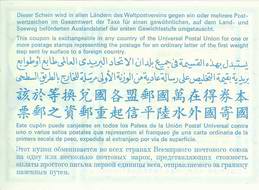 |
| Picture 12 | |
|
The new selling price of HKD1.20 denomination was effective on 2 July 1971 (Picture 14) and a very small portion of the Coupon with 80 cents rubber chop was added in manuscript of HKD1.20 ¡V representing the current selling price of the Coupon was still in use until the stock exhausted (Picture 13). |
|
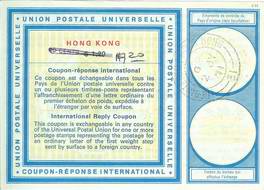 |
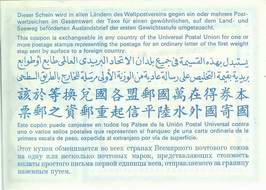 |
| Picture 13 | |
 |
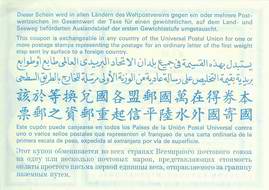 |
| Picture 14 | |
|
A small modification was made at around 1974 with ¡§Gebühr¡¨ replaces ¡§Taxe¡¨ on the German text on the back (Picture 15). |
|
 |
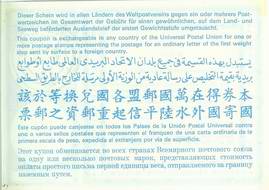 |
| Picture 15 | |
|
Another new type of Coupon was adopted and later introduced in the 1974 Lausanne Congress with ¡§(date facultative)¡¨ in left hand box, ¡§C22¡¨ on the top right hand corner and ¡§by surface to a foreign country,¡¨ on the back. The first date of issue in Hong Kong is 2 January 1975 for this type of International Reply Coupons (Picture 16). |
|
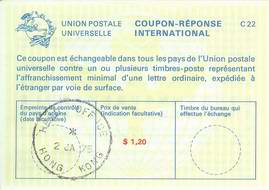 |
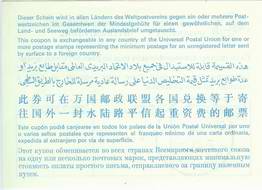 |
| Picture 16 | |
|
Price was once again adjusted to HKD2.00 on 2 January 1976 with a rubber chop being used to overprint the old denomination still in use (Picture 17) until the arrival of the newly printed HKD2.00 Coupons later the same year (Picture 18). |
|
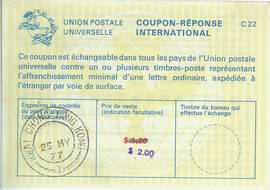 |
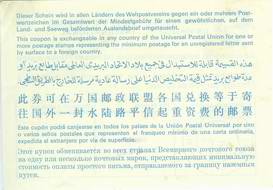 |
| Picture 17 | |
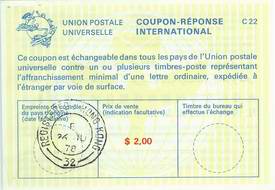 |
 |
| Picture 18 | |
|
Selling price of the Coupons increased to HKD3.00 in 1981 with a rubber chop being applied to old denomination Coupon still in various post offices stock (Picture 19 in purple ink, Picture 20 in black ink) until the old stock exhausted and the HKD3.00 Coupon was finally put into use at around 1982 (Picture 21). A modification of the type was being issued in 1984 and dispatch to branch offices without ¡§date facultative¡¨ in the left hand side box (Picture 22 and Picture 23). |
|
 |
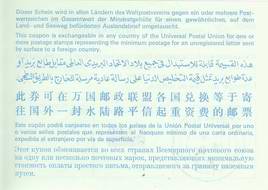 |
| Picture 19 | |
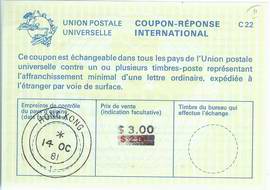 |
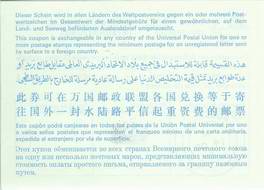 |
| Picture 20 | |
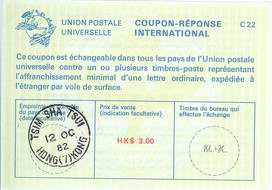 |
 |
| Picture 21 | |
 |
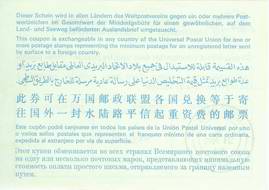 |
| Picture 22 | |
 |
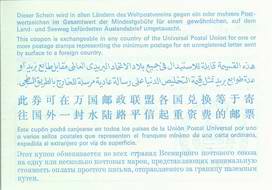 |
| Picture 23 | |
|
Selling price increased to HKD6.00 in January 1986 (Picture 26) following a revision of Postal Services Charge with both the new type and the old HKD3.00 type overprinted by a rubber chop being used at the same time (Picture 24 and Picture 25). |
|
 |
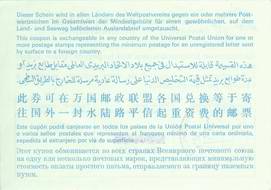 |
| Picture 24 | |
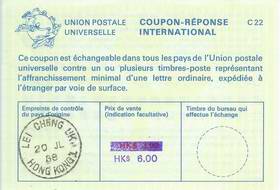 |
 |
| Picture 25 | |
|
On 1 September 1988, the denomination was increased to HKD8.00 following an adjustment of the overall postage charge (Picture 27). Following the decision of the International Bureau of the Universal Postal Union, with effective from 1 January 1991, an International Reply Coupon, including those of the old types, started to be exchangeable in any member of the Universal Postal Union for one or more postage stamps representing the minimum postage for an unregistered letter sent by air to a foreign country. |
|
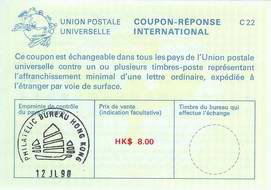 |
 |
| Picture 27 | |
|
A new Lausanne Type was put into use at around early 1992 with ¡§facultative¡¨ and without ¡§date¡¨ in the left hand box, ¡§par voie aerienne.¡¨ ends main paragraph on front and ¡§sent by air to a foreign country¡¨ on the back in all languages (Picture 28). |
|
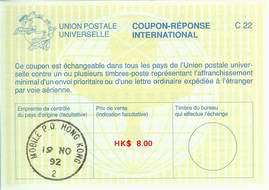 |
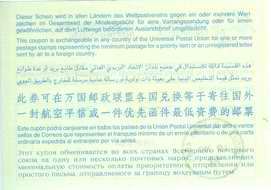 |
| Picture 28 | |
|
Although both ¡§sent by surface¡¨ and ¡§sent by air¡¨ type of International Reply Coupons was both in circulation and sold over post office counters, the recipients of which can still exchange them with stamps of airmail postage until April 1992 which the Financial Services Division of the Hong Kong Post Office took remedial action and arranged for the old type International Reply Coupons to be withdrawn from sale. Since then, only the ¡§sent by air¡¨ type of International Reply Coupons is being sold over post office counters all over Hong Kong. ¡@ At around middle of 1993, a new type with a small printed date of 9.1992 at the lower left margin on the front was brought to circulation at the same denomination of HKD8.00. This is the first type with printing date being applied to International Reply Coupons (Picture 29). |
|
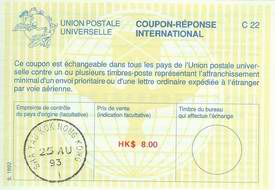 |
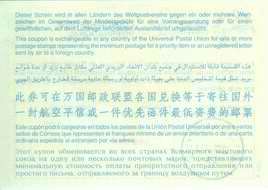 |
| Picture 29 | |
|
Following a revision of the Postal Services Charge, the denomination of the International Reply Coupons was adjusted to HKD10.00 commencing from 1 November 1992. Coupons were still with a small printing date of 9.1992 at the lower left margin on the front. However, some old denomination HKD8.00 with a rubber chop HKD10.00 was widely used at various branch post offices within the territory of Hong Kong (Picture 30 and Picture 31). |
|
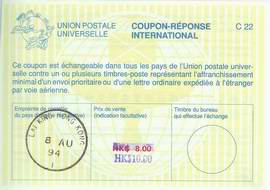 |
 |
| Picture 30 | |
 |
 |
| Picture 31 | |
|
With the acquisition of additional stock at around the end 1994, a new version with a small printing date of 8.1993 at the lower left margin on the front was brought to circulation (Picture 33) together with the old 9.1992 type with the same selling price of HKD10.00 (Picture 32). |
|
 |
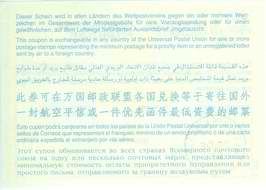 |
| Picture 32 | |
 |
 |
| Picture 33 | |
|
At the 1994 Seoul Congress, form C22 became form CN01. This decision followed a proposal by the Executive Council of the Universal Postal Union (UPU) to rationalize forms. This type of International Reply Coupons remained in force until 31 December 2001. From that date onwards, any International Reply Coupons of the pre-2002 type will be withdrawn from post offices but customers can still be able to exchange them at any membership administration of the Universal Postal Union. ¡@ On 1 June 1995, a new denomination of HKD14.00 International Reply Coupons was put into use following a revision of all Postage Services Charge in Hong Kong. These Coupons were imprinted with a small printing date of 8.1993 on the left lower corner (Picture 34). Again, Coupons with old denomination was being overprinted by purple rubber chop to cover the old value and chopped with the new denomination of HKD14.00 to be used and sold over post office counters simultaneously. Both types of 9.1992 (Picture 35) and 8.1993 (Picture 36) could be bought in various branch offices until a newly 4.95 type was introduced in 1996. This type is easy identified by the ¡§CN01 (ancien C22)¡¨ imprinted on the top right hand corner (Picture 37). This type was used even after the transfer of Sovereignty of Hong Kong on 30 June 1997. At around 2000, a new revised type of HKD14.00 denomination International Reply Coupons was in circulation with a printing date of 10.98 on the lower left hand corner (Picture 38). This type had been widely used until the introduction of a new type of International Reply Coupon on 2 January 2002. |
|
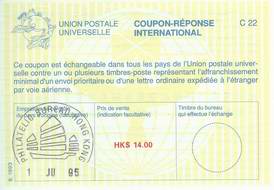 |
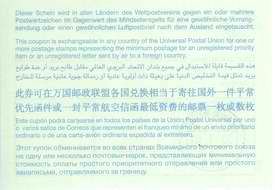 |
| Picture 34 | |
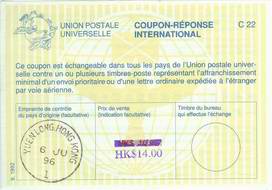 |
 |
| Picture 35 | |
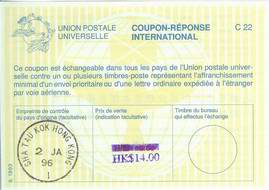 |
 |
| Picture 36 | |
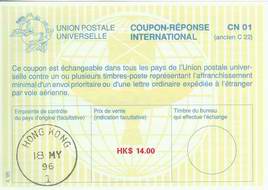 |
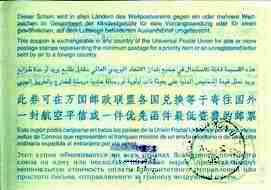 |
| Picture 37 | |
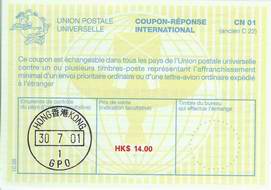 |
 |
| Picture 38 | |
|
The new type of International Reply Coupon (Picture 39) was released on 2 January 2002 at a selling price of HKD14.00 were valid for exchange of stamps representing the minimum postage prepaid on an unregistered item sent abroad by air (i.e. HKD3.00). On the first date of sale, a total of 2,691 pieces were sold at all branch post offices in Hong Kong. |
|
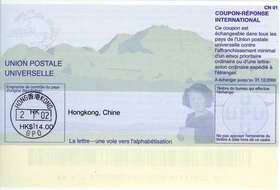 |
 |
| Picture 39 | |
|
With a size of 148mm x 102mm, a distinctive UPU (Universal Postal Union) watermark is adopted on the front as a security feature whilst a barcode and a series of OCR (Optical Character Reader) readable characters are printed on its back. The first two English characters represent the abbreviation of the place of issuance in French. HK stands for Hong Kong, China. 20011119 indicate the ordered date of these Coupons which is 19 November 2001 while 20061231 marks the expiry date or last day of exchange of this Coupon which is 31 December 2006. The third group of number and the last two English letters is an enhance security measure which is the serial number and the check digit known as follows:
Lastly, 074 is the SDR (Special Drawing Right) which represent the monetary value of these Coupons at the Universal Postal Union. Selling Price is decided by respective Postal Administration but the selling price fixed by the administrations concerned may not be less than this value. ¡@ Although all UPU member administrations have been required to exchange International Reply Coupons since the 1920 Madrid Congress, the sale of the International Reply Coupons is optional and membership administrations may decide at any time whether or not to sell them. Additionally, individual membership administration may decide the date of release upon receipt of ordered stock from the International Bureau of the Universal Postal Union with Headquarters in Berne, Switzerland. ¡@ International Reply Coupons introduced in Hong Kong Since 1960
¡@ Illustrations of International Reply Coupons Issued in Hong Kong Since 1950 Addendum
Two more types of International Reply Coupon had been introduced in 2006 and 2007 respectively. The type introduced in 2006 is named the ¡§Beijing Model No. 2¡¨ (Picture 40) which replaces the ¡§Beijing Model No. 1¡¨ which had been valid from 2002 to 2006. The type introduced in 2007 is the Centenary Version of the ¡§Beijing Model No. 2¡¨ type to celebrate the Centenary of the Issuance of International Reply Coupon in 2007 (Picture 41).
|
|||||||||||||||||||||||||||||||||||||||||||||||||||||||||||||||||||||||||||||||||||||||||||||||||||||||||||||||||||||||||||||||||||||||||||||||||||||||||||||||||||||||||||||||||||||||||||||||||||||||||||||||||||||||||||||||||||||||||||||||||||||||||||||||||||||||||||||||||||||||||||||||||||||||||
|
|
|
||||||||||||||||||||||||||||||||||||||||||||||||||||||||||||||||||||||||||||||||||||||||||||||||||||||||||||||||||||||||||||||||||||||||||||||||||||||||||||||||||||||||||||||||||||||||||||||||||||||||||||||||||||||||||||||||||||||||||||||||||||||||||||||||||||||||||||||||||||||||||||||||||||||||
|
Picture 40 |
|||||||||||||||||||||||||||||||||||||||||||||||||||||||||||||||||||||||||||||||||||||||||||||||||||||||||||||||||||||||||||||||||||||||||||||||||||||||||||||||||||||||||||||||||||||||||||||||||||||||||||||||||||||||||||||||||||||||||||||||||||||||||||||||||||||||||||||||||||||||||||||||||||||||||
|
|
|
||||||||||||||||||||||||||||||||||||||||||||||||||||||||||||||||||||||||||||||||||||||||||||||||||||||||||||||||||||||||||||||||||||||||||||||||||||||||||||||||||||||||||||||||||||||||||||||||||||||||||||||||||||||||||||||||||||||||||||||||||||||||||||||||||||||||||||||||||||||||||||||||||||||||
|
Picture 41 |
|||||||||||||||||||||||||||||||||||||||||||||||||||||||||||||||||||||||||||||||||||||||||||||||||||||||||||||||||||||||||||||||||||||||||||||||||||||||||||||||||||||||||||||||||||||||||||||||||||||||||||||||||||||||||||||||||||||||||||||||||||||||||||||||||||||||||||||||||||||||||||||||||||||||||
![]()